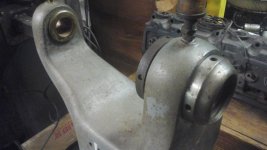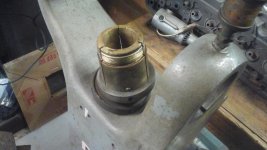M.B. Naegle
Diamond
- Joined
- Feb 7, 2011
- Location
- Conroe, TX USA
This task has a few specifics I'd like to nail down, so I figured I'd start a separate thread from the general rebuild thread here:
https://www.practicalmachinist.com/vb/antique-machinery-and-history/brainard-small-hand-milling-machine-388135/
Brief recap: I picked-up a boat-anchor, incomplete machine, because I didn't want to see it melted down, or turned into a homebrew C-and-C job. I like it because it's unique, small (easy to find floor-space), and I think the age commands a little respect (made sometime between 1871 and 1899). One of the holes to fill is that it's missing the spindle.
The dimensions for it are easily obtained as both bronze bearings remain and catalog photos indicate nothing special. In general, I need a bar of stock that's 2 1/2" at the largest diameter and 16 1/4" long. The largest diameter is the non-critical OD of the front flange, so material that's exactly 2 1/2" would be fine. The front bearing behind that is 1.875 OD with take up nuts threaded to the shaft behind it, center section for cone pulley and rear bearing all turned to 1.500 OD. The center will be bored 3/8" through, and have a Brown & Sharpe #7 taper reamed into the front. I'd like to add a tang drive slot behind that, but there would be no place for a drift, so I'll just use the drawbar for tool ejection and plug the outside of the slot, leaving the center slotted for tang driven endmills and such (which I have a lot in store). My research has turned up that 4140 pre-hard is the ideal spindle material, but I have 3 problems with that.
1. The middle diameter (front bearing) needs threads cut into it for take-up nuts. I've no ability to grind threads and don't expect good results with cutting pre-hard threads.
2. The whole 16" length needs a 3/8" bore for a draw-bar. Again, conventional cutting methods.
3. Cost. A 4140 pre-hard bar is going to run $250-300 which isn't in the budget for a side project like this unfortunately.
I've also considered going with annealed 4140 to cover the first two points. However, still not cheap, and the hardening process adds the additional concerns of:
4. Making the threads brittle, and potentially warping the overall piece. Both issues would be corrected by post hardening grinding, but again I don't have thread grinding resources. For OD grinding, my tool n' cutter grinder is a ways from functionality (however a pending job could offer motivation), so any OD grinding could be done via TP grinder on the lathe, or dimensions made close enough to be finished by hand on the lathe (stone/Emory cloth), or I make some kind of thread grinding attachment for the T&CG, (which as an asside is a 1900 Cincinnati who's operating range means that the newer Cinci tooling won't fit and I'll need to make everything for it
 ).
).
So one other option I'm considering is going with 1018 CR steel and case hardening it. This covers the first three issues as it'll easily machine and I have a bar of it on hand already. My only issue with this route is problem 4 is still a concern.
So, does anyone have any input as to the best methods to case harden threaded tubes with minimal distortion or thread brittleness?
One thing I'm considering is that this isn't going on a high precision, high speed machine. While manufacturer's would take greater care making a part like a spindle, it was still done with pre-1900's tech, so how did they do it? Also I'm thinking that my tolerance for a pre-1900 spindle can be open as well. If I can cut everything to size, I'm confident I can get the taper to run at least .0005" or better concentric to the front bearing without any grinding, which IMO is pretty good for a pre-1900 hand-operated production milling machine.
So correct me if I'm wrong, but a 1018 spindle made to size, case hardened and polished; what problems will I see? what would you do different? What about just leaving the spindle soft? The tool taper and front face I think would benefit the most from hardening, so could I just case harden those surfaces and leave the rest soft? I'm thinking about case hardening by packing in a sealed case of carbon (powdered charcoal), but if I only do that to the front face, I'm thinking that burning off oxygen in the remaining space would be tricky without also burning up the charcoal.
https://www.practicalmachinist.com/vb/antique-machinery-and-history/brainard-small-hand-milling-machine-388135/
Brief recap: I picked-up a boat-anchor, incomplete machine, because I didn't want to see it melted down, or turned into a homebrew C-and-C job. I like it because it's unique, small (easy to find floor-space), and I think the age commands a little respect (made sometime between 1871 and 1899). One of the holes to fill is that it's missing the spindle.
The dimensions for it are easily obtained as both bronze bearings remain and catalog photos indicate nothing special. In general, I need a bar of stock that's 2 1/2" at the largest diameter and 16 1/4" long. The largest diameter is the non-critical OD of the front flange, so material that's exactly 2 1/2" would be fine. The front bearing behind that is 1.875 OD with take up nuts threaded to the shaft behind it, center section for cone pulley and rear bearing all turned to 1.500 OD. The center will be bored 3/8" through, and have a Brown & Sharpe #7 taper reamed into the front. I'd like to add a tang drive slot behind that, but there would be no place for a drift, so I'll just use the drawbar for tool ejection and plug the outside of the slot, leaving the center slotted for tang driven endmills and such (which I have a lot in store). My research has turned up that 4140 pre-hard is the ideal spindle material, but I have 3 problems with that.
1. The middle diameter (front bearing) needs threads cut into it for take-up nuts. I've no ability to grind threads and don't expect good results with cutting pre-hard threads.
2. The whole 16" length needs a 3/8" bore for a draw-bar. Again, conventional cutting methods.
3. Cost. A 4140 pre-hard bar is going to run $250-300 which isn't in the budget for a side project like this unfortunately.
I've also considered going with annealed 4140 to cover the first two points. However, still not cheap, and the hardening process adds the additional concerns of:
4. Making the threads brittle, and potentially warping the overall piece. Both issues would be corrected by post hardening grinding, but again I don't have thread grinding resources. For OD grinding, my tool n' cutter grinder is a ways from functionality (however a pending job could offer motivation), so any OD grinding could be done via TP grinder on the lathe, or dimensions made close enough to be finished by hand on the lathe (stone/Emory cloth), or I make some kind of thread grinding attachment for the T&CG, (which as an asside is a 1900 Cincinnati who's operating range means that the newer Cinci tooling won't fit and I'll need to make everything for it

 ).
).So one other option I'm considering is going with 1018 CR steel and case hardening it. This covers the first three issues as it'll easily machine and I have a bar of it on hand already. My only issue with this route is problem 4 is still a concern.
So, does anyone have any input as to the best methods to case harden threaded tubes with minimal distortion or thread brittleness?
One thing I'm considering is that this isn't going on a high precision, high speed machine. While manufacturer's would take greater care making a part like a spindle, it was still done with pre-1900's tech, so how did they do it? Also I'm thinking that my tolerance for a pre-1900 spindle can be open as well. If I can cut everything to size, I'm confident I can get the taper to run at least .0005" or better concentric to the front bearing without any grinding, which IMO is pretty good for a pre-1900 hand-operated production milling machine.
So correct me if I'm wrong, but a 1018 spindle made to size, case hardened and polished; what problems will I see? what would you do different? What about just leaving the spindle soft? The tool taper and front face I think would benefit the most from hardening, so could I just case harden those surfaces and leave the rest soft? I'm thinking about case hardening by packing in a sealed case of carbon (powdered charcoal), but if I only do that to the front face, I'm thinking that burning off oxygen in the remaining space would be tricky without also burning up the charcoal.





